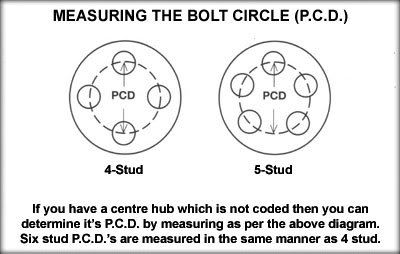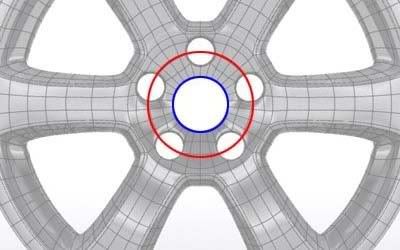When buying a set of alloy wheels, there are some important details you need to look at to see whether the wheels you are interested in will fit your car. The first is the PCD, or Pitch Circle Diameter, then there is the spigot size and the other is the offset, also referred to as the ET (which is from the German word 'Einpresstiefe' translated as 'insertion depth').
So what is PCD (Pitch Circle Diameter)?
Consider the wheel on your car and in particular the holes where the bolts hold the wheel to the car. Now imagine someone has taken a compass and from the center of the wheel has drawn a circle that passes through the center of the bolt holes. The diameter of this circle is the Pitch Circle Diameter and is measured in millimeters.

Although the PCD strictly only refers to the diameter of this circle, the PCD specification for a set of alloy wheels will also tell you the number of bolt holes, which will usually be either 4 or 5.
So if a wheel has a diameter of 100mm and has 4 bolt holes, the PCD specification will read as 4x100.
This does not however mean that the wheels from one car that have a PCD of 4x100 will necessarily fit another car whose tires have a PCD of 4x100. This is because they may have a different spigot size.
So what is the spigot size?

The spigot is located in the center of the wheel hub and is what holds the wheel in place while you locate the bolt holes.
On most after-market alloy wheels, the spigot hole will be bigger than the spigot on the wheel hub. To get around this you will need to use a spigot ring, this fits over the spigot on the wheel hub to increase the size to fit correctly within the spigot hole on the inside of the alloy wheel.
It would be possible to attach a wheel to a wheel hub without a correctly fitting spigot, although it would be tricky to hold in place while screwing in the bolts. This would not be advisable for another reason though. The other purpose of the spigot is to carry most of the weight of the vehicle. If it did not fit correctly all the weight of the car would carried by the bolts, which are not designed to do this. They would likely sheer off if you drove the car too hard or braked too heavily, which is obviously not good!
You may also find that the wheels go in and out of balance.
So what is the offset (ET)?
The offset is the measurement, in millimeters, between the center of the wheel (not side on, but turned to face you) and the bolt face (this is not the same as the outer most edge).
There are two different types of offset. There is a positive offset, where the bolt face is closer to the outside edge of the wheel than the center of the wheel, this is most common on normal road cars. And there is a negative, where the bolt face is closer to the inside edge of the wheel than the center of the wheel.
Therefore, if you put a wheel on your car that has a bigger positive offset than the previous one, the wheel will sit further in towards the car. And alternatively, if the positive offset is smaller, or even changed from a positive to a negative offset, the wheel will sit further out from the car.
For performance purposes you can improve grip and traction by going for wider wheels and tyres, but in order to do this you will need to go for wheels with a smaller offset to allow for the extra width in the wheel arch. If you went for wider wheels that had too high an offset, the tyres would probably make contact with the inside of the wheel arch, causing damage to both the tyre and the arch.
Wheel Size
When buying a new set of alloy wheels it is easiest to select a size that is equal to that of the current wheels, so you would replace 13” steel wheels with 13” alloy wheels.
But you may want to change the width and profile of the tires for better performance. Again it is best to try and approximately match the overall diameter of your current wheels and tires. To work out what you can go for you can use the specifications found on the side of your tires. This would look something like 165/80/R13.
We can work out the overall width of wheel and tire as follows:
The first number is the width of the tire and the second is the profile height expressed as a percentage of the width, so the profile height is 80% of 165mm. (165x80)/100 = 132mm. This is the height of the profile of the tire, this needs to be multiplied by two for the height on either side of the wheel. 132x2 = 264mm. This figure can be converted into inches by multiplying by 25.4. 264/25.4 = 10.39”. We then add the last number, 13, which represents the diameter of the wheel. 10.39+13 = 23.39”. So the total width of wheel and tire is 23”.
If we looked at a wider 15” tyre with the specification of 245/50/14 and did the same calculation:
(245x50)/100 = 122.5mm. 122.5x2 = 245mm. 245/25.4 = 9.63”. 9.63+14 = 23.65”.
So although the new wheel is wider, the profile of the tire is lower, making the overall width within a few fractions of an inch of the old wheel and tire.
Conclusion
Ultimately, unless you are planning on buying some second-hand wheels and tyres, or having them handed down to you, you will probably be buying them from a professional store, either in person or online. The best advice is simply to ask the experts, they will know exactly what PCDs, spigots, offsets and wheel/tires sizes will be appropriate for your car.
So what is PCD (Pitch Circle Diameter)?
Consider the wheel on your car and in particular the holes where the bolts hold the wheel to the car. Now imagine someone has taken a compass and from the center of the wheel has drawn a circle that passes through the center of the bolt holes. The diameter of this circle is the Pitch Circle Diameter and is measured in millimeters.

Although the PCD strictly only refers to the diameter of this circle, the PCD specification for a set of alloy wheels will also tell you the number of bolt holes, which will usually be either 4 or 5.
So if a wheel has a diameter of 100mm and has 4 bolt holes, the PCD specification will read as 4x100.
This does not however mean that the wheels from one car that have a PCD of 4x100 will necessarily fit another car whose tires have a PCD of 4x100. This is because they may have a different spigot size.
So what is the spigot size?

The spigot is located in the center of the wheel hub and is what holds the wheel in place while you locate the bolt holes.
On most after-market alloy wheels, the spigot hole will be bigger than the spigot on the wheel hub. To get around this you will need to use a spigot ring, this fits over the spigot on the wheel hub to increase the size to fit correctly within the spigot hole on the inside of the alloy wheel.
It would be possible to attach a wheel to a wheel hub without a correctly fitting spigot, although it would be tricky to hold in place while screwing in the bolts. This would not be advisable for another reason though. The other purpose of the spigot is to carry most of the weight of the vehicle. If it did not fit correctly all the weight of the car would carried by the bolts, which are not designed to do this. They would likely sheer off if you drove the car too hard or braked too heavily, which is obviously not good!
You may also find that the wheels go in and out of balance.
So what is the offset (ET)?
The offset is the measurement, in millimeters, between the center of the wheel (not side on, but turned to face you) and the bolt face (this is not the same as the outer most edge).
There are two different types of offset. There is a positive offset, where the bolt face is closer to the outside edge of the wheel than the center of the wheel, this is most common on normal road cars. And there is a negative, where the bolt face is closer to the inside edge of the wheel than the center of the wheel.
Therefore, if you put a wheel on your car that has a bigger positive offset than the previous one, the wheel will sit further in towards the car. And alternatively, if the positive offset is smaller, or even changed from a positive to a negative offset, the wheel will sit further out from the car.
For performance purposes you can improve grip and traction by going for wider wheels and tyres, but in order to do this you will need to go for wheels with a smaller offset to allow for the extra width in the wheel arch. If you went for wider wheels that had too high an offset, the tyres would probably make contact with the inside of the wheel arch, causing damage to both the tyre and the arch.
Wheel Size
When buying a new set of alloy wheels it is easiest to select a size that is equal to that of the current wheels, so you would replace 13” steel wheels with 13” alloy wheels.
But you may want to change the width and profile of the tires for better performance. Again it is best to try and approximately match the overall diameter of your current wheels and tires. To work out what you can go for you can use the specifications found on the side of your tires. This would look something like 165/80/R13.
We can work out the overall width of wheel and tire as follows:
The first number is the width of the tire and the second is the profile height expressed as a percentage of the width, so the profile height is 80% of 165mm. (165x80)/100 = 132mm. This is the height of the profile of the tire, this needs to be multiplied by two for the height on either side of the wheel. 132x2 = 264mm. This figure can be converted into inches by multiplying by 25.4. 264/25.4 = 10.39”. We then add the last number, 13, which represents the diameter of the wheel. 10.39+13 = 23.39”. So the total width of wheel and tire is 23”.
If we looked at a wider 15” tyre with the specification of 245/50/14 and did the same calculation:
(245x50)/100 = 122.5mm. 122.5x2 = 245mm. 245/25.4 = 9.63”. 9.63+14 = 23.65”.
So although the new wheel is wider, the profile of the tire is lower, making the overall width within a few fractions of an inch of the old wheel and tire.
Conclusion
Ultimately, unless you are planning on buying some second-hand wheels and tyres, or having them handed down to you, you will probably be buying them from a professional store, either in person or online. The best advice is simply to ask the experts, they will know exactly what PCDs, spigots, offsets and wheel/tires sizes will be appropriate for your car.







No comments:
Post a Comment